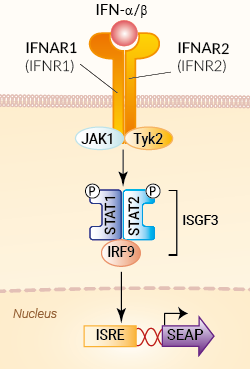IFN-α/β Reporter B16 Cells
| Product | Unit size | Cat. code | Docs. | Qty. | Price | |
|---|---|---|---|---|---|---|
|
B16-Blue™ IFN-α/β Cells Murine Type I IFNs Sensor Cells |
Show product |
3-7 x 10e6 cells |
bb-ifnt1
|
|
||
|
B16-Blue™ IFN-α/β vial Additional cell vial |
Show product |
3-7 x 10e6 cells |
bb-ifnt1-av
|
Notification: Reference #bb-ifnt1-av can only be ordered together with reference #bb-ifnt1.
Murine Type I IFNs Reporter Cells

Signaling pathway in B16-Blue™ IFN-α/β cells
B16-Blue™ IFN-α/β cells were engineered from the murine B16 melanoma cell line to detect bioactive murine type I interferons (e.g. IFN-α, IFN-β) by monitoring the activation of the JAK/ISGF3 pathway. ISGF3 is a signaling complex comprising STAT1, STAT2, and IRF9. In addition, these cells can be used for screening antibodies or small molecule inhibitors targeting the IFN-α/β pathway.
IFN-α and IFN-β are important anti-viral cytokines that also have anti-proliferative and immunomodulatory functions [1, 2].
Cell line description
B16-Blue™ IFN-α/β cells were generated by stable transfection with the secreted embryonic alkaline phosphatase (SEAP) reporter under the control of the ISG54 promoter. This promoter comprises IFN-stimulated response elements (ISRE) that are recognized by the ISGF3 complex. The binding of IFN-α or IFN-β to their receptor triggers a signaling cascade leading to the activation of ISGF3 and the subsequent production of SEAP. This can be readily assessed in the supernatant using QUANTI-Blue™ Solution, a SEAP detection reagent.
B16-Blue™ IFN-α/β cells respond specifically to murine (m) IFN-α/β and do not respond to human (h) IFN-α/β. Stimulation of these cells with mIFN-α or mIFN-β, or type I IFN inducers, such as poly(I:C), poly(dA:dT) or 5’ppp-dsRNA delivered intracellularly, triggers the production of SEAP by the activation of the IRF-inducible promoter. Of note, B16-Blue™ IFN-α/β cells do not respond to mIFN-γ (see figures).
Key features
- Fully functional murine IFN-α/β signaling pathway
- Readily assessable ISRE-inducible SEAP reporter activity
- Strong response to murine IFN-α/β
- No response to human IFN-α/β
- No response to murine IFN-γ
Applications
- Detection of murine IFN-α and IFN-β
- Screening of anti-mIFN-α/β or anti-mIFNAR antibodies
- Screening of small molecule inhibitors of the IFN-α/β pathway
References:
1. Schreiber G. 2017. The molecular basis for differential type I interferon signaling. J. Biol. Chem. 292:7285-94.
2. McNab F. et al., 2015. Type I interferons in infectious disease. Nat Rev Immunol. 15(2):87-103.
Specifications
Detects murine type I interferons:
- Detection range for mouse IFN-α: 102 - 104 IU/ml
- Detection range for mouse IFN-β: 10 - 104 IU/ml
Antibiotic resistance: Zeocin®
Growth medium: DMEM, 4.5 g/l glucose, 10% (v/v) heat-inactivated fetal bovine serum, 2 mM L-glutamine, 100 µg/ml Normocin™, 100 U/ml penicillin, 100 µg/ml streptomycin
Guaranteed mycoplasma-free
Back to the topContents
- 1 vial containing 3-7 x 106 cells
- 1 ml of Zeocin® (100 mg/ml)
- 1 ml of Normocin™ (50 mg/ml)
- 1 ml of QB reagent and 1 ml of QB buffer (sufficient to prepare 100 ml of QUANTI-Blue™ Solution, a SEAP detection reagent)
![]() Shipped on dry ice (Europe, USA, Canada and some areas in Asia)
Shipped on dry ice (Europe, USA, Canada and some areas in Asia)
Details
Type I interferons, in particular interferon-alpha (IFN-α) and interferon beta (IFN-β), play a vital role in host resistance to viral infections [1, 2]. The type I IFN family is a multi-gene cytokine family that encodes 14 partially homologous IFN-α subtypes in mice (13 in humans), a single IFN-β, and several poorly defined single gene products (IFN-ɛ, IFN-τ, IFN-κ, IFN-ω, IFN-δ, and IFN-ζ) [1, 2]. IFN-α and IFN-β are the best-defined and most broadly expressed type I IFNs [2].
IFN-β and all of the IFN-α subtypes bind to a heterodimeric transmembrane receptor composed of the subunits IFNAR1 and IFNAR2 which are associated with the tyrosine kinases Tyk2 and Jak1 (Janus kinase 1) respectively. These kinases phosphorylate STAT1 and STAT2 which then dimerize and interact with IFN regulatory factor 9 (IRF9), leading to the formation of the ISGF3 complex. ISGF3 binds to IFN-stimulated response elements (ISRE) in the promoters of IFN-stimulated genes (ISG) to regulate their expression.
1. Schreiber G. 2017. The molecular basis for differential type I interferon signaling. J. Biol. Chem. 292:7285-94.
2. McNab F. et al., 2015. Type I interferons in infectious disease. Nat Rev Immunol. 15(2):87-103.








